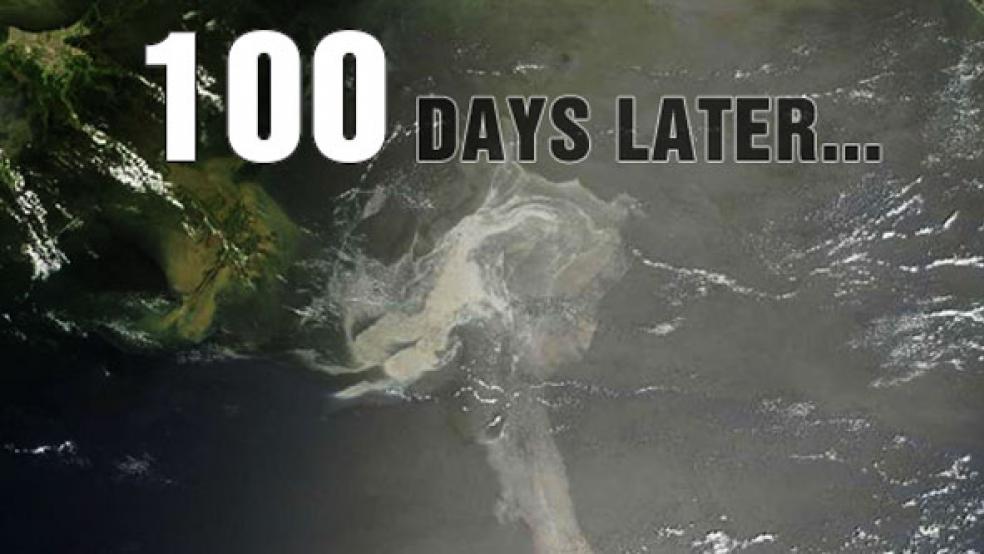The oil sheen may finally be disappearing from the surface of the Gulf of Mexico, but 100 days after BP’s Deepwater Horizon rig exploded on April 20, questions remain about the future of deepwater drilling. Eleven people were killed, 17 were injured, and a vibrant local economy has been savagely compromised, just when it was finally rebounding from the devastation of Hurricane Katrina. On top of that, an important ecosystem continues to suffer environmental impacts that will play out for years to come. And yet the moratorium on deep-water drilling in the Gulf and elsewhere is also taking a toll. Offshore oil drilling employs thousands of Americans, drives local economies and provides nearly 30 percent of the nation’s oil supply.
Two responses that may help bridge the gap between environmental protection and economic interests have, ironically, been initiated by the oil companies. BP has removed CEO Tony Hayward following the public relations disaster that he created. Bob Dudley, BP’s new CEO, says the company has increased the money to cover spill-related cleanup costs to a whopping $32.2 billion. And he has reiterated BP’s promises on clean up and compensation. In the past 100 days, the firm has lost $60 billion in market cap, or about 35 percent of its value. BP also faces penalties and lawsuits that will take years, perhaps decades, to resolve.
A second initiative was announced last week by four oil companies who are committing $1 billion to develop new technologies and plans that they say will ensure swift containment should another spill occur.
Still, at the 100 day mark, with many unresolved and unknown issues, the focus will be on the future of the Gulf and on America’s energy needs and commitments.
Environmental Impact
Scientists aren’t surprised that large sheens are no longer being detected, explained Breck Owens, a Woods Hole oceanographer who maps Gulf currents. “A lot of [surface oil] does evaporate. A significant proportion of oil coming out of the well was natural gas, and that’s going to dissolve or evaporate,” he said. What’s far more disturbing, however, are the “microbes in the water that eat oil at [great] depths and use up oxygen. The anoxic layers are down deep, and fish can’t live there.”
Plumes of oil have been reported beneath the surface of the water for weeks now, but “nobody has a really good answer as to how long it’s going to take for that to be broken down,” said Alan Schiller, marine sciences professor at the University of Southern Mississippi. “Sediment and creatures on the bottom could be poisoned.” He added ominously, “In the next couple of years, it’s going to be very interesting to see what happens to fish populations.”
Jane Lubchenco of the National Oceanographic and Atmospheric Administration (NOAA) seconded the worries about damage largely unseen. “Less oil on the surface doesn’t mean that oil isn’t beneath the surface, or that beaches and marshes aren’t still at risk.”
Spills Aren’t Going Away Any Time Soon
Two days ago a tugboat rammed an oil wellhead in southeastern Louisiana, 65 miles south of New Orleans, sending a spray of oil and gas about 100 feet into the air. By Tuesday afternoon, an oil sheen about a mile long was seen near the well, which is owned by Cedyco, a Houston-based company. Since April 20 at least two additional oil spills have occurred in the Gulf of Mexico region.
But oil leaks are scarcely confined to the Gulf, as most people know: think Exxon Valdez in Alaska, 1989. Think Nigeria, 2010, where residents who roam through dead zones can find neither fish nor fowl. Just this past Wednesday, the state of Michigan grappled with a spill of over a million gallons after a leak in 41-year-old pipe carrying oil from Indiana to Ontario was discovered. Governor Jennifer Granholm of Michigan declared a state of emergency along the Kalamazoo River and told reporters, “There are not enough resources on the river right now.”
Bottom line: Where there are wells, there will be spills. The special commission that President Obama created in May has been tasked with reforming federal oversight of spills and oil industry practices, but it’s just begun hearings and its recommendations, whatever they may be, remain months away.
The Moratorium on Deepwater Drilling Needs To Be Lifted
This country needs oil and it needs jobs – and the Gulf, fragile as it may be, is still ripe with both possibilities. Currently the Gulf of Mexico produces about 25 percent of this country’s crude oil and about 15 percent of its natural gas.
Along with the thousands of jobs scrapped and the billions in lost wages and spending because of the ban on deepwater drilling, oil companies are worried about their businesses and their shareholders. So Exxon, Mobil, Chevron and ConocoPhillips—four of the big five—have created a new oil spill response and containment plan. New equipment and enhanced procedures will be “rapidly deployable,” according to John Roper of ConocoPhillips.
Yesterday Senator Mary Landrieu (D-La.) held a hearing on Capitol Hill to examine the economic impact of the moratorium. Mincing no words, she said the ban “borders on reckless. Thousands of Gulf Coast businesses are confronting a second economic disaster that not only threatens jobs and businesses, but also a way of life.” She said she shares the administration’s goal of a “safer oil and gas industry, but not its method to achieve that.”
Many others have voiced similar concerns. “Even though this [spill] is a terrible tragedy, the economy of Louisiana is so dependent on oil and gas that to absolutely shut down drilling in the Gulf Coast will devastate the state," said Congressman Anh “Joseph” Cao of Louisiana.
The Long-Term Health Impacts of Oil Spills
“It would make sense to see some excesses in cancer, other lung diseases, and neurologic conditions,” said Dr. Edward Trapido, a cancer epidemiologist at Louisiana State University. “But right now, since we didn’t follow up on the Exxon Valdez, we just don’t know.”
Linda McCauley, dean of Emory University’s nursing school, said recently, “Because of the pure volume of chemicals in the area from the oil and the dispersants, [oil spill] workers could be exposed to skin and eye irritations, dizziness, headaches, and respiratory problems. It’s very toxic work, and heat stress can be deadly.” Psychological and emotional stresses carry their own risks, of course.
The CDC has admitted knowing very little about the chronic health effects of oil spills. “When you look at the world’s literature, you have maybe less than 40 articles you could possibly turn to, and not all of them very high quality,” said John Howard, director of occupational safety and health, before a Senate panel in June.
| BP: One Hundred Days Later | $230 billion: The estimated value of BP’s global production assets (not including its refining or marketing businesses). $25-30 billion: The value of the exploration and production assets the company now plans to sell. $23 billion: The amount the oil spill could cost coastal economies over a three-year period. 2 months: Transition period between the company’s booted chief executive Tony Hayward, 53, and its newly anointed CEO, Robert Dudley, age 54. Dudley is an American who grew up in Mississippi. 28 years: Length of time Hayward has worked for BP. $18 million: What BP is paying Hayward in benefits to step down as CEO. $17 billion: What the company lost in the second quarter, according to its reports. $4 billion: BP’s approximate cost to date of dealing with the spill, including containment and cleanup. $256 million: What BP says it’s paid out so far to individuals and businesses, 185 million gallons: Estimated amount of oil that has leaked into the Gulf between April 20 and July 15, when the current sealing cap was installed. (Many believe the actual number is much higher.) 2,980: Number of dead birds collected since the spill, according to the U.S. Fish and Wildlife Service. |




